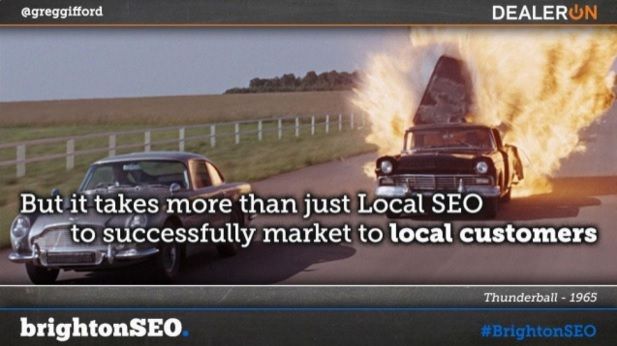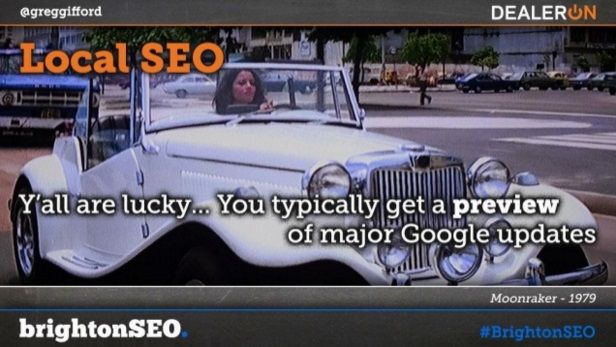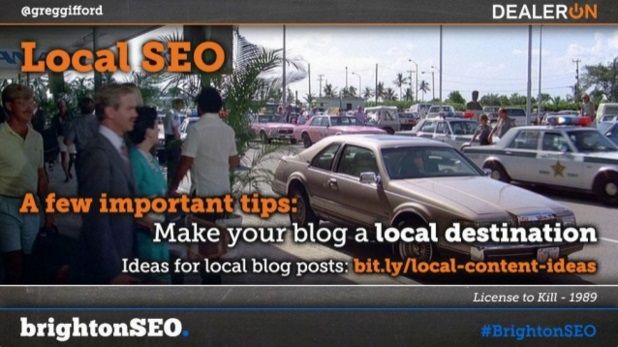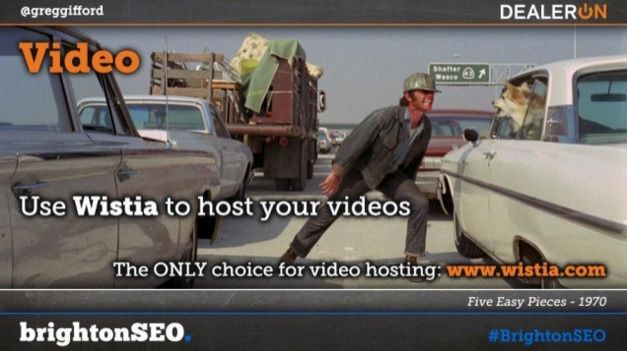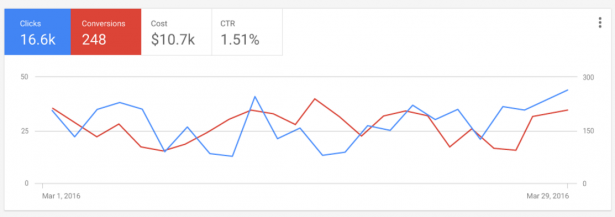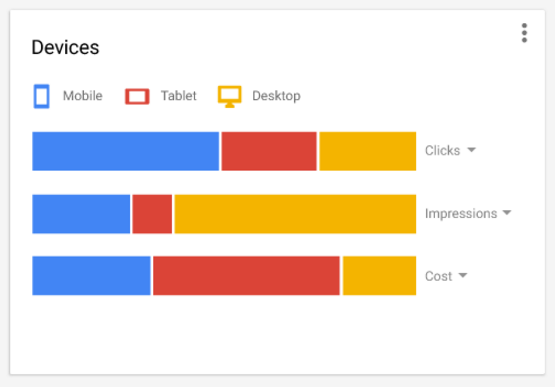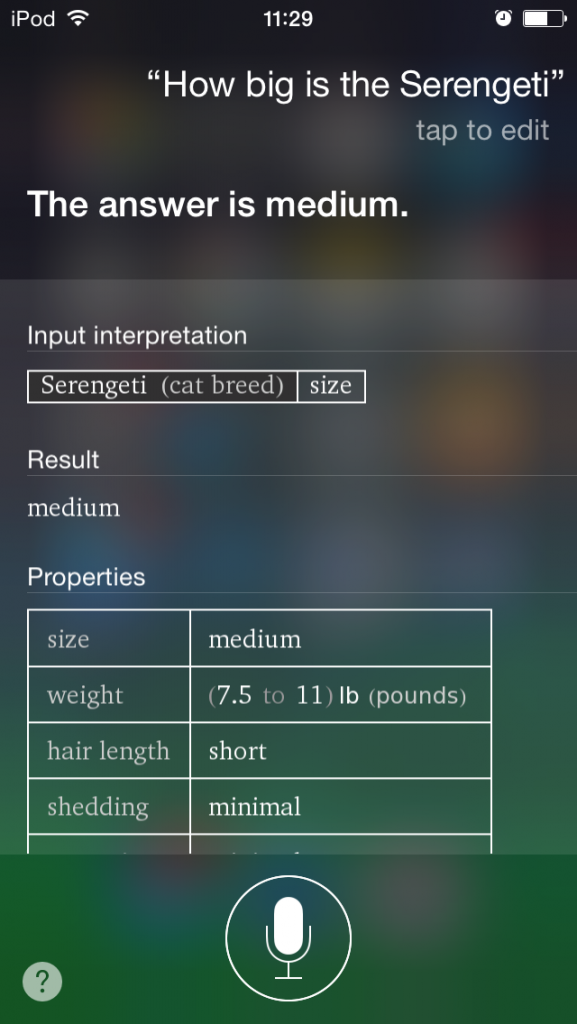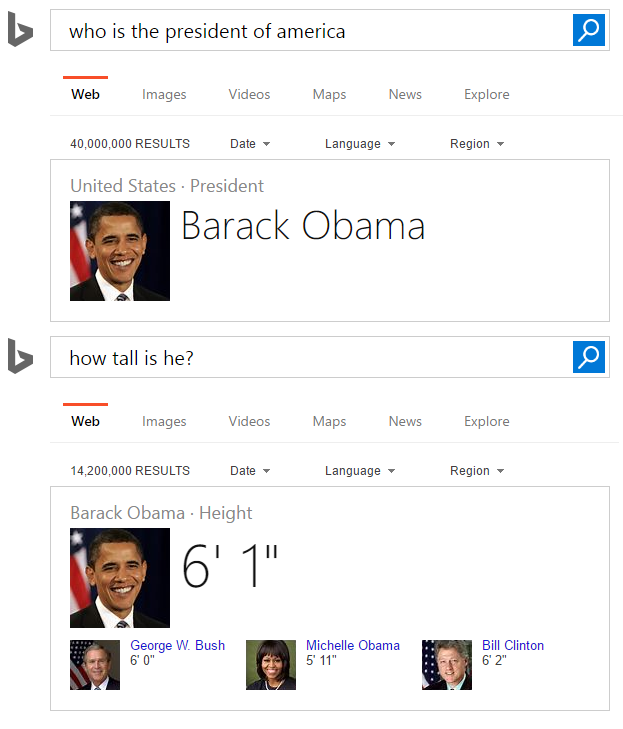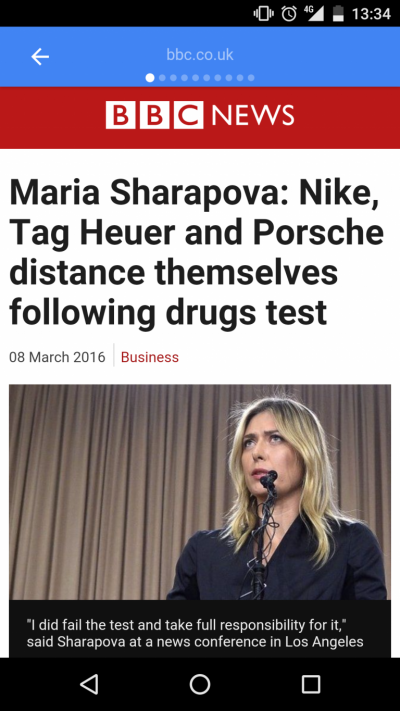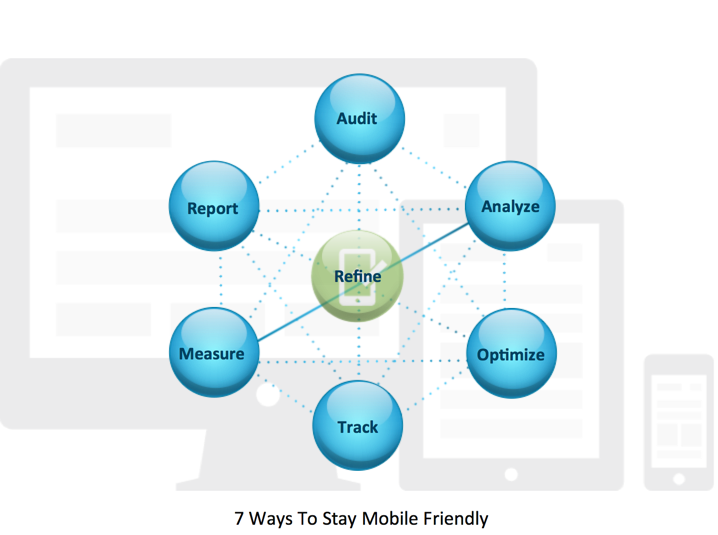Saturday, April 30, 2016
how to sign up for paycation www.justwinningforme.com
how to sign up for paycation www.justwinningforme.com
via https://www.youtube.com/channel/UCtEc-WTq7uPoVuEFP1FEY-Q
Thursday, April 28, 2016
Taking your analytics practice to the next level
As both a Googler and ClickZ team member, I recently attended and participated in the always-inspirational ClickZ Live New York event.
Along with Katie Morse, Vice President, Social and Search at Nielsen and Pierce Crosby, business development and experienced data analyst at StockTwits, we had a panel discussion on how brands can take their analytics practice to the next level.
First, a quick description of the panel:
Data has become everyone's domain, in all aspects of your marketing and business. Most companies do a good job at collecting and reporting data and have a basic process in place. But many are stuck as to what to do next to elevate value of data in their company.
As our conversation, and those questions the audience asked, were so good, I wanted to pull out some of the best questions and summary of answers we shared with attendees.
Pierce, Katie, and Adam presenting at ClickZ Live NYC. Photo by Search Engine Watch columnist Thom Craver (used w/permission).
1. Most companies have varying groups that need access to analytics insights. How do you efficiently get them all what they need and how do you ensure it's most useful for them?
The answer is process. Ensure that you have the right metrics delivered to the right people at an anticipated frequency. Also ensure that you have conducted proper resource allocation in order to allow time not just to share dashboards, but flesh out insights for your teams to take action on.
If you are just delivering dashboards without context, you're not doing your job. Actually, you're performing the job a script can do – which isn't a good place to be.
The more formalized you can be with your processes, the better, as this will make you incredibly efficient and free up time for the creative, valuable (and fun!) analyst projects.
2. How do you see a breakdown of time spent on analytics between data capture, reporting, and analysis? What are the best ways to help get organizations to move up the value chain?
The more time you can spend on analysis, the better. But if you're not capturing the right data and reporting it in an articulate way, your analysis won't be accurate or defensible. That's why it's important to spend time up front on ensuring your data quality is excellent and you're effortlessly generating beautiful reports.
Need some hard numbers to serve as a guideline? Aim for 10% of time spent on data capture, 20% on reporting, and 70% on analysis and delivering insights to your team (my previous ClickZ column goes over the reporting part in more detail).
The way to get an organization to move up the value chain is easy: trend down the time you spend on capture and reporting. It'll happen organically.
3. Can you talk about how you are using data across tactics - such as how does search inform social, email or other areas of marketing?
Data should not exist in a silo. You should be using it to inform everything you do, and you should be using it to understand your users, not simply to fill in dashboards.
For example: if you notice visitors to your ecommerce site are frequently querying a product name or type you don't have in site search, you should share this data with your product team and persuade them to offer it. Marketing isn't just about promoting products anymore.
Marketing now needs to be involved in the actual strategic decisions companies make, and data is how we get a seat here. Our user data should be informing what we do next, not just showing successes of our sites and apps. This all starts with breaking down silos and using insights cross functionally – beyond marketing.
4. Let's talk about goal setting: how you can quantify success outside of just ROI? What are some other metrics that we might want to take a look at?
ROI in dollar terms is great. Everyone can understand this, especially your CFO. But generating revenue is just one outcome from your marketing and content, and just one thing to optimize.
For example, if your call center or social CRM team notices a recurring question about your company's product they have to answer repeatedly, that's a huge opportunity. What you need to do in this type of situation is measure what your user's problems are and use this information to power answers in an automated / self-service fashion such as an FAQ page on your site or chatbot.
Creating this type of content in a data-driven manner can help trend down easily answered questions, freeing up your customer service team to focus on tougher problems which require a human touch and making your customers happier by simply getting the information they need immediately. That's a win-win: and very measurable!
5. What are some actionable ways or things we could all do to become better at analyzing the “what happened” and “why” at our metrics?
This is an area of practice makes perfect. The answer is to hire skilled leaders for your team that can inspire and grow your team's analyst skills. But personal growth helps too: so attending events like ClickZ Live, trainings and courses (such as our Analytics Academy) and reading blogs and books (like Avinash's definitive book, Web Analytics 2.0).
Although, there is simply no substitute for hands on experience at making data-drive decisions and becoming fluent in the world of digital measurement.
Working at an agency and on hundreds of clients across industries helped me get to where I am, so that's a path I can personally recommend. Although there's no reason you can't build your skills in-house too.
To learn more about the changing face of digital marketing, come to our two-day Shift London event in May.
Wednesday, April 27, 2016
17 fascinating stats about beacons and location marketing
Today we embark on our fifth weekly #ClickZChat, where the good people of SEW and ClickZ take to Twitter to discuss with our expert friends and followers a particularly burning digital marketing related issue.
For this week's chat, we'll be talking about location marketing, NFC, beacons, and their usefulness for marketers, so please join us at 12pm EST (5pm UK) on Wednesday 27 April.
As preparation for the discussion, I've pulled together as many stats relating to beacons as I could possibly find, many of which should provide fuel for the conversation and maybe aid your own location marketing strategy.
1) The value of in-store retail sales influenced by beacon-triggered messages in the United States in 2015 and 2016 was $4.1 billion.
2) In 2016, an extraordinary $40 billion increase is estimated. Statista suggests that beacon messages will trigger retail sales worth $44.4 billion in the US.
![]()
3) Men are more likely than women to make a purchase based on personalized advertising they saw on an in-store beacon or display.
4) Among responding male internet users aged between 18 and 34 years, 91% said they were influenced by personalized in-store advertising. Female internet users influenced by in-store beacon tech amounted to 76%.
![]()
5) More than 42% of companies already have proximity marketing (such as beacons and geolocation) in place. 39% say they will implement it in the next three years. 18.6% say they have no plans for beacons.
6) The future plans for beacon technology integration is trailing in popularity behind online basket comparison (42%), in-store Wi-Fi (54.3%), scan-and-go (59.3%) in-store bookmarking (62.8%).
[Source: Statista]
7) 46% of retailers have launched beacon programs in 2015, up from 15% in 2014.
8) 71% retailers are able to track and understand customers' buying patterns using beacons.
9) 65% feel they are able to target customers down to the aisle level.
10) 59% feel customers are more engaged in the store.
11) 53% retailers feel they are able to create more relevant and compelling offers in the store.
12) 24% retailers saw an increase in sales.
13) 24% retailers saw an increase in offer redemption,
[Source: Retail Touchpoints and reported by Beaconstac]
14) 82% of customers make purchase decisions in-store. [Google]
15) By 2018, the beacon installed base will consist of 4.5 million active beacons overall, with 3.5 million of these in use by retailers.
![]()
16) Half of the top 100 retailers in the US tested beacons in 2014, this was expected to increase to one-third of their store locations by the end of 2015.
17) Globally, it's estimated that 570 million Android and Apple smartphones are compatible with Bluetooth low energy (BLE), the signal used by beacons to trigger smartphone apps. This is one-third of the smartphone installed base.
[Source: Business Insider]
Tuesday, April 26, 2016
Beyond local SEO: Greg Gifford on how to win the visibility race
Last Friday at a packed-out Brighton SEO conference, expert local search consultant Greg Gifford delivered a fast and furious presentation on the secrets of local marketing visibility: it's not just about local SEO.
In a slide-show brimming with references to classic car movies, Greg Gifford raced through a host of tips and tricks that can massively improve your business's local visibility and let you storm ahead of the competition.
The days of “just having a website” and trying to make it rank near the top are over; it takes more than just SEO to market to local customers. That's not to say that local SEO isn't important, of course, but it shouldn't be your only consideration.
By thinking about local SEO as just one part of a wider visibility strategy, you can ensure that your business has a presence across multiple channels, not just in search. That's better for your customers as well as for you.
In his talk, Gifford gave a run-down of other key areas to pay attention to, and how to optimise each one to target exactly the local audience you want to attract.
But first, because search is still hugely important for a local business, here are some handy tricks that Greg Gifford shared which will help you get ahead in the SEO game.
Quick tips for local SEO
Future-proof your SEO tactics
You only need to look at pizza delivery for an example of how much weight local visibility now carries in search, more than ever before. If you Google “pizza delivery”, even without specifying a location, Google will serve you local results – whether you asked for them or not.
Any algorithm changes that Google makes to its local search results have the potential to shake things up hugely, and the businesses who adapt fastest are often those who end up on top.
Google's 'Pigeon' update in 2014 was a massive game-changer for local SEO, and mobile-oriented ranking changes like Mobilegeddon can have a huge impact on local given that 94% of mobile searches have local intent.
But if you live outside the US, you're in luck (for once!): Google algorithm updates always hit the US before they roll out anywhere else, so by keeping an eye on what's happening in the States, you can 'future-proof' your SEO tactics and know exactly what to do by the time the update comes to you.
And even if you live in the US, there's still a way you can get ahead: Gifford recommends keeping an eye on Moz.com's local search ranking factors research, an extensive survey conducted across SEO experts analysing the changes in ranking factors they have observed over the past year. This will give you the low-down on what changes search experts sense in the winds and how they recommend dealing with them.
Make your blog a local destination
Maintaining a blog is still an excellent content and SEO strategy, giving businesses a platform to publish regular, fresh and insightful content and build a relationship with their visitors.
But in the words of Greg Gifford, “Don't just market your shit!” Make your blog a local destination; share all sorts of things that people want to read.
Visitors will be turned off by a blog that is clearly just another mouthpiece for the company to promote its products. By thoughtfully curating all sorts of valuable local content, you can turn your blog into a go-to destination, boost its visibility and build relationships and links with other local blogs and businesses.
And speaking of local businesses…
Get those local business links!
When it comes to inbound links to your website, businesses will fight tooth and nail to try and get links from sites with the most domain authority. But Greg Gifford's tip is one that many businesses wouldn't even consider: go after “crappy little church websites”. You know the ones, with Microsoft Word clipart and neon green Comic Sans font in the header.
These kinds of tiny hyper-local websites have a huge amount of local relevance, and so their links carry a lot of weight. Best of all, none of your competitors will be going after them, so you can snap them up and enjoy the boost.
 Increase your local SEO with inbound links from highly hyperlocal websites – even if they aren't always of the best quality. Photo by Lincolnian, made available via CC BY-SA 2.0
Increase your local SEO with inbound links from highly hyperlocal websites – even if they aren't always of the best quality. Photo by Lincolnian, made available via CC BY-SA 2.0
Build 'local silos' to show up in nearby cities
If you want your site to show up in search for a city you're not located in, Gifford recommends building what he calls 'local silos' targeted at nearby cities.
A silo is the name given to a system or sector that operates in isolation from others. You've probably heard a lot about we should be breaking down silos, but in this case, they can work to your advantage.
To build 'local silos', create little self-contained zones of information within your site that are based around the city or neighbourhood you want to target and optimise the heck out of them.
Publish blog posts about that city, get links back from local businesses, and make sure they point to pages within the silo; and before too long, you'll see your silos start to rank in local searches for that area.
 Building silos can be a good thing, when it comes to local SEO. Photograph by Doc Searls, made available via CC BY 2.0.
Building silos can be a good thing, when it comes to local SEO. Photograph by Doc Searls, made available via CC BY 2.0.
Track your Google My Business clicks
In the midst of all the cool local SEO hacks, it pays to remember the basics, like making sure your business is listed on Google My Business and your profile is complete.
Gifford also advises adding tracking parameters to your Google My Business links in order to monitor the traffic coming to your site via that page. Local SEO Guide has a good guide on how to do this with Google's URL builder tool.
It's also worth keeping an eye on developments with Google Posts, which Google seems to be prepping as a significant platform for business promotion, and which could possibly be the next major development in local search if Google rolls it out on a larger scale.
How to optimise your email marketing
So we've covered the 'local SEO' part of local visibility; how about the 'beyond'? Greg Gifford's first tip might seem a little old-school, but it's still one of the most effective marketing tools at your disposal: email marketing.
Gifford advises making sure that you're using a responsive email design. Brands who have fully embraced responsive emails see 55% more Clicks to Open (CTO) from mobile and 23% more from desktop compared to brands who haven't, according to research by Yesmail.
Adding video to your emails can increase their attractiveness and interactivity, and a survey conducted by Forrester Marketing Group found that including a video in email marketing increased Click-Through Rate by 200 to 300%.
That statistic is from 2010, but more recent statistics have shown that just including the word “video” in an email subject line can raise open rates by 19% and Click-Through Rates by 65%.
Having a carefully curated list of email addresses to target can also come in handy when using Facebook Ads, as we'll see later on.
Go beyond YouTube
If you're going to commit to using video in your marketing strategy, Gifford has one key recommendation for you: don't use YouTube. Instead, the video hosting service that Gifford recommends for keeping control of your content and tracking the important metrics is Wistia.
Here are some of the reasons he lists for opting for Wistia instead of YouTube or another major video host:
- Wistia provides detailed video analytics, including engagement statistics, trend graphs, and individual viewer 'heatmaps' which show the parts of a video each user watched, skipped and rewatched.
- You can tie user information to email addresses, and also use Wistia's 'Turnstile' tool to add a form that requires users to input their email address at any point before, after or during the video.
- Wistia allows you to give your videos a custom play button, which according to Wikia's former Director of Growth and Acquisition Casey Henry can increase your play rate by 19%.
- Similarly, you can also add a custom thumbnail to your videos, which can potentially boost your play rate by as much as 35% (and often winds up looking much nicer).
- Wistia embeds on Facebook play in the news feed, and on Twitter will expand into a Twitter card that also allows users to play them in-stream.
Facebook ads
“Facebook ads used to be the drunk guy that showed up late to the party; now, they're the cool guy that everyone's stoked to see,” says Gifford. And if you're looking to gain local visibility, Facebook ads have a lot of valuable advantages.
- Facebook's demographic targeting is incredibly diverse and exact, allowing you to target users based on location, age, gender, interests, and some mind-bogglingly specific parameters like education level, device and mobile connection.
- You can also load in email lists and use them to create a custom audience of Facebook users who have accounts registered with those addresses.
- Facebook also allows you to create Lookalike Audiences which will target new groups of people who are similar to audiences you're already targeting.
- Facebook's 'local awareness ads' are an incredibly powerful local advertising tool. Google research on local search showed that roughly 70% of users want ads customised to their city or zip code, and between 60 and 70% want ads customised to their immediate surroundings.
Facebook's local awareness ads allow you to drop a pin on any point on a map, and ads will be shown on mobile devices within a certain radius of that point. Try dropping a map pin on your competitors, on an event or at a conference!
Use Beacons
Gifford's final hot tip for local visibility is to use Beacons. Beacons are “small, Bluetooth-enabled hardware devices that can be installed in physical locations, like retail stores. They silently broadcast a message to any Bluetooth-enabled devices in their proximity, kind of like a lighthouse with text”, as Dan Cristo writes.
Usually Beacons require a dedicated app to work, but Beacon providers have begun setting up app networks which will allow Beacons to pop up a message on someone's phone as long as any app in the network is running.
The apps are location-aware, so they can be tagged by the Beacon even if they aren't running. You can then connect directly to Facebook's API, allowing you to retarget ads at actual foot traffic.
DealerOn, Gifford's marketing and advertising company, ran some tests with Beacon and found they led to anything from a 34.6% to a 45.7% increase in Click-Through Rate on ads. At a recent conference, the Beacon at DealerOn's booth tagged 687 unique users.
Beacons are still an emerging technology, but they have the power to improve the customer experience and potentially revolutionise search – especially in a hyperlocal context. So watch out for opportunities and get creative with how you use them.
Monday, April 25, 2016
Smarter digital assistants and the future of search
It's search Jim, but not as we know it.
The dream of an ultimate personal assistant isn't a farfetched sci-fi fantasy like the interactive computing systems in Star Trek. It's technology available today already being applied to search engines.
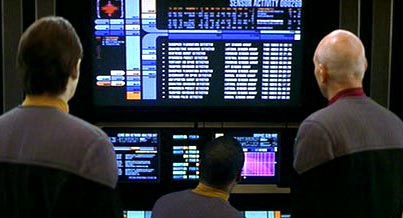
Leading visionaries in search technology, including Google's Beshad Behzadi in his keynote speech at the SMX West Keynote to Satya Nadella at Microsoft's Build conference, are articulating a vision of smarter and more capable personalized help that will drive efficiency, focus and ultimately, happiness.
Nadella believes the next big bet for Microsoft is “conversation as a platform.” This is a more intuitive and accessible canvass integrating into apps, as well as artificial intelligence (A.I.) and bots that can interact with other bots. While the devices and technology used to access search are evolving, search will still be an increasingly integral part of everyday life.
Understanding intent through voice search
Today's digital assistants like Microsoft's Cortana, Apple's Siri and Google Now are voice-search enabled and growing smarter with every interaction. According to comScore, 50% of all searches will be voice searches by 2020.
Since voice search is more conversational and uses natural language, the A.I. is evolving to understand user intent and context based on the previous search queries, multiple step queries and user behavior.

Words can provide invaluable substance to A.I. technology during the search process. For marketers, the longer query strings from voice search as compared to text provide richer user intent data. While a text query would typically be one to three words, a spoken query is often three or more.
For example, on my desktop I would search for “blue t-shirt.” But when it comes to a voice query, I might ask, “Hey Cortana, where can I find a cool blue t-shirt?” The conversational tone provides a signal of intent to purchase, style preference and desired shopping locations if I granted access to my location. It permits marketers to:
- Build user-intent models to understand where the user is in the customer journey.
- Match advertising campaigns (messaging and landing pages) to the right stage of user intent.
- Develop site content with a conversational tone, providing specific answers to users' needs and top questions. Voice searchers are looking for quick answers. Content answering specific questions will make your site a go-to resource.
AI, the 'Added Ingredient' for enhanced consumer experience and engagement
Technology giants like Microsoft, IBM and Google are focusing on new ways machine-based learning, A.I. and bots can analyze data. Personal assistants like Cortana, powered by Bing search intelligence, can request permission to gather data from email accounts, calendars, social networks, geo-locations and mobile apps to start learning about behaviors and preferences.
The A.I. engine analyzes the information to make recommendations before they have a chance to ask a question. The more interactions a user has with their assistant, the more accurate the predictive models can be – and the more her serendipitous proposals will delight us and make life easier.

For many, the end of the day reads like a frustrating laundry list of stuff that still needs to get done – including the laundry! Efficiency is now one of the keys to happiness, and technology give us back time to be in the moment.
If I give my personal assistant access to the locations that are important to me and my calendars, she can send reminders when I need to leave to make it on time to my next appointment.
The predictive component A.I. can monitor traffic and figure out if I need to leave work now to pick my son up from day care because of a freeway accident.
It can deep link into apps, such as Waze, and suggest the best alternative routes based on current road conditions.
Soon, this intelligence will integrate into shared intelligence across A.I. bots, and tasks such as renewing your driver's license will be done on my behalf and save me time.
For marketers, it's important to understand and adapt to this new technology to build immersive customer experiences. As deep-linking and intelligent agents are integrated into apps and products, consumer engagement with brands will reach the next evolution. This means there is more potential than ever to influence the path to purchase in the customer journey.
While “Beam me up Scotty” and journeys to the final frontier are not yet a reality for most of us, the capabilities and technology for building the ultimate digital assistant are almost here.
This new “other” way to get things done will make it more appealing for consumers to share personal data so that assistants can become more predictive and take actions on our behalf.
We'll continue to use search, websites, and apps. But how we interact with them will provide more intent and context for A.I.s and bots to help us get things done in our daily lives. This way we can focus and be fully present in the moments that matter the most.
Steve Sirich is GM Marketing, Bing Ads, Microsoft and a contributor to Search Engine Watch.
For lots more information, download our Marketer's Guide to Artificial Intelligence report, which takes a look at how AI can be used for marketing, now and in the future.
Sunday, April 24, 2016
Wednesday, April 20, 2016
How mobile transformed an 80 year-old catalogue retailer
In four years Shop Direct has gone from selling the majority of its products via twice yearly catalogue to an entirely digital operation that sell the majority of its products via the mobile web.
British catalogue retailer Shop Direct has transformed itself from a paper-based into a pure-play digital business.
In 2012, 72% of sales came from catalogues. In 2016 it will be 0%. Today Shop Direct's £1.8 billion business is 100% digital.
The first mobile web sale was booked in early 2010, now mobile accounts for a whopping 61% of revenue and is still growing strongly. And how has it effected the bottom line? Well, last financial year pre-tax profits for the group were up 78%.
Jonathan Wall, Group ecommerce director, explains to ClickZ how mobile came to dominate Shop Direct's business.
Tell me about how things have changed since you put out your last catalogue.
There has been a huge transformation of the business from being a catalogue to an online retailer. Our last catalogue was produced in April 2015. It was a huge piece of work preparing for this as a business, but in the end the last catalogue went quite quietly.
You might have thought that a business that had been producing catalogues for 80 years would have a bit of a fanfare or even a civil ceremony around the last catalogue. But thankfully as a business we had already moved on.
We didn't want to remove our catalogues until our customers were predominantly online. But we had reached the stage when our customers had started to say: “Why are you still sending this to me? That's not what makes me buy from you.”
Are you able to tell how much business you might have lost, presumably there were some customers who didn't shop online?
Of the small number of people who were using the catalogue, most were also buying online. For the tiny minority who don't want to browse online, there's still an option to receive and shop from brochures.
But this was about the transforming the way we do business. If you are only producing two catalogues a year it dictates the whole way the business works internally – this means you are producing fashion and setting up products for every six months.
So it was having a major effect on the business and how we worked.
So your cycle of buying was determined by production of the catalogue?
Absolutely. Because our summer catalogue come out in January we would have to have bikinis on the shelf in January when people were still buying woolly jumpers and warm coats.
So removing the catalogue gave us a big advantage with respect to buying and merchandising and how we stocked our shelves.
And were you able to use your analytics to see what proportion of customers stayed with you as you moved online?
We used hold-out groups. We'd pick a set of similar customers and we send some of them a catalogue and not to others.
It soon became obvious from those hold-out groups that those customers who didn't receive the catalogue still continued to shop with us. It showed that the catalogue was not incremental and customers just weren't valuing it as much as they used to.
So how much of the business is mobile these days? How quickly did you see mobile growing and what stage are you at now?
So we took our first mobile order in the beginning of 2010. By the end of 2010 mobile was only about 2% or 3% of our orders, but it was nearly 7% of our visitors.
It rapidly became apparent that mobile was going to be a huge part of our business. So we focused heavily on getting our mobile web journey right.
Back then there was a disparity of devices – Android was just starting off, there was iOS, BlackBerry, Windows, Symbian was still around.
That meant we would have needed to develop lots of apps, so we decided we would just have one journey across all browsers, which is why we focused on mobile web. Unlike most of our competitors were developing apps for all these different services.
What proportion of the business is digital and what proportion of that is mobile? Do you measure in revenue or orders? And is it still growing?
100% of our business is digital and 61% is mobile. That's revenue. And yes, mobile is still growing very strongly.
Tablet is slowing down, but mobile web is having its second surge of growth at the moment.
Why is mobile surging now? Why is tablet slowing down?
Now that smartphones have larger screen sizes, people just aren't using tablets as much. Everything else is growing, while tablet stays the same, so it is declining as a proportion of our business.
When it comes to a shopping experience the tablet just isn't as important to the customer as it has been.
We do a lot of research with our customers, but we have done some special home sessions recently. It is obvious that customers don't think about getting their laptop or tablet out any more.
When they're sitting on the couch and see something they want to buy on the TV, the mobile phone is the first thing they pick up, rather than their tablet.
Do you think this is down to improvements in mobile phones, networks or mobile websites?
I think it is a result of many things. First, mobile sites are much better now. Everyone is doing a reasonable job – and in some cases a good job – of delivering a decent mobile experience.
Second, the technology is getting much stronger: people are getting better WIFI in their homes, mobile screens are getting bigger and customer behavior is changing, they're becoming much more comfortable with mobile devices.
Have you stuck with the mobile web-only approach?
We stuck with mobile web until December 2014 when we launched our first iOS transactional app. We'd had various apps before, such as catalogue apps, but nothing that allowed purchases.
But in December 2014 we took the decision to launch an iOS app for Very and then in July 2015 an Android app also for Very.
We knew it was a good app, but we were delighted by how receptive our customers have been to it.
Are your apps native, hybrid or web-based apps? I believe that retailers often go for hybrid apps as they are easier to integrate into backend e-commerce systems than native apps.
We have a hybrid app… this is a conversation that comes up very often with our ecommerce team. We have a hybrid app where we use the best of native app development where it is needed.
So, for instance, on my account, where customers can see the balance on their credit account or see where all their orders are, is native.
Any where we want special features, where native development will help, we are absolutely native. So roughly 50% of the customer journey is native – all the non-shopping is in a native environment.
However once they enter the shopping experience it is mobile web.
So when it comes to purchasing, it's a web app?
Yes it's mobile web. The first reason that we do this is because it is one code base, though there is slightly different code between the hybrid app and the normal mobile web.
The second reason is that we have developed a reasonably good journey for our customers in their shopping experience and we believed this experience is still optimized within a mobile web app.
It is a really interesting one this, because there are some retailers who are going purely native, some who are taking the same course as us, and some retailers who still have an automated experience using one of the companies that just turn your mobile website into an app.
There is still a market for that sort of solution but we believe the best way is hybrid.
Are you able to track customers from web to mobile to app? If I put a product in my basket on my laptop will that be in my basket on the mobile web and app also?
Yes, if you place a product in your basket or save for later on the desktop or whatever device, when you get into your app it will still be there.
So who is downloading your app, is this existing customers on the desktop/mobile web or new business?
Predominantly it is existing customers coming onto the app as opposed to bringing in new ones. But we still use mobile web as our main acquisition tool.
How do you use mobile web as an acquisition tool? What's proving most effective?
We use the usual suspects, such as Google and Facebook to drive people to the mobile website. Once they have shopped with us, we will deliver messages saying “Download our app now”.
They will be targeted on our sites, but we also target potential customers off-site, identifying them using cookies.
Google, Facebook and display advertising in general have been the most effective ways to get people to download our apps. This is our first 12 months of app, so we are still learning in this area.
But Google want to use us – along with our agency SOMO – as a case study, as we've had great success with using data we already have on our customers to target them off site with ads to download our app.
What is your customer demographic if I am allowed to ask?
Miss Very is our bullseye customer – she is a 25 to 45 year old woman with children and a partner.
Obviously we have customers across the entire spectrum, but Miss Very is how we like to portray our target customer to our teams so they have a better understanding.
Do you have pictures of her on the wall?
Absolutely. But she is actually a real person, she isn't a caricature.
When we brought Miss Very into the business it helped our teams get a really clear understanding of who they were marketing to – who we were trying to deliver our message to. It has really helped us in our brand marketing.
What level of customer loyalty do you have?
We don't share the numbers, but we do have a lot of loyal customers. So many of our customers hold an account with us – so our customers have the option to pay now on a cash account or on a credit or debit card or they can use one of our finance offerings.
Plus, we are a department store that sells a lot of products across a lot of categories.
Want to know more about the challenges and benefits of digital transformation? Make sure you check out Shift, our new event in London this May.
Nick Wilsdon on Enterprise SEO and Customer Acquisition [podcast]
Welcome to the latest episode of the ClickZ Digital Marketing Podcast.
In this week's edition, we interview search expert Nick Wilsdon on the current and future state of enterprise SEO and customer acquisition.

You'll learn about the latest developments in search engine optimisation and what opportunities these present for marketers. Nick also shares some practical advice for getting started and what he thinks will be the main areas of growth over the coming months.
Nick Wilsdon started his online career in 1998 and is currently the SEO lead at Vodafone Group where he's standardising and improving online performance across 22 markets and 55 partner markets.
You can listen to the full podcast here: ClickZ Digital Marketing Podcast Episode 6, but in the meantime are some of the highlights from his 40 minute chat:
09:34 – The move beyond links
Nick comments that the biggest change for SEOs in the last few years has been the move away from the siloed area of links and link acquisition into content and how content is used. “SEO has to be widely engaged with the other campaigns within a business.” It's a broader discipline.
11:22 – Joining up TV campaigns with online behaviour
Marketers need to be much more savvy when it comes to building mini-campaigns around keywords used in broadcast advertising, as this drives much of viewers' subsequent online behaviour.
13:39 – How important are links for SEO?
Despite recent pushes for social ranking signals to be acknowledged, Google is still a “link-graph and that's the basis for the entire search engine.” However it's the way we earn links that has fundamentally changed.
19:41 – The biggest changes for SEO over the next few years
Nick discusses SEO's continued growth in importance within organisations, which is tied into the growth in traffic that SEO drives. But it needs to become “mobile-first” in order to keep up, and this extends to app-optimisation. Nick goes on to describe the fundamental differences between SEO and mobile SEO.
21:52 – Opportunities for local search
From the largest national chain to the smallest independent store, every retailer needs a good local search strategy and Google provides a variety of tools to help these businesses. Nick discusses a few of these recent developments.
24:09 – Major risks for brands not using SEO
“The biggest risk is not taking it seriously enough.” Nick expands upon this and further discusses the problems with not using data and using the “wrong people.”
25:30 – Practical tips for SEO
Nick rounds out the podcast with lots of helpful guidance on what you should be concentrating on when it comes to modern search marketing, including making sure your site is running on a secure protocol, as well as recommendations for tools you should be using.
Nick is speaking at Shift London, our new event aimed at the altered minds, business models, skill sets, buying habits and marketplaces driven by digital disruption – and the ensuing transformation imperative. Book your place today.
Monday, April 18, 2016
Paid search rules for ROI on mobile: report
Lead generation and direct online sales represent the two most important objectives for mobile marketers and paid search is the key mobile channel for achieving these objectives.
This is according to our new ClickZ Intelligence report on the State of Mobile Advertising 2016, produced in partnership with Search Optics and based on a global survey of more than 400 marketers and digital professionals.
At least half of the respondents cited lead generation and direct online sales as their main aims when running mobile paid search (70%), social (50%) and display advertising (54%) campaigns.
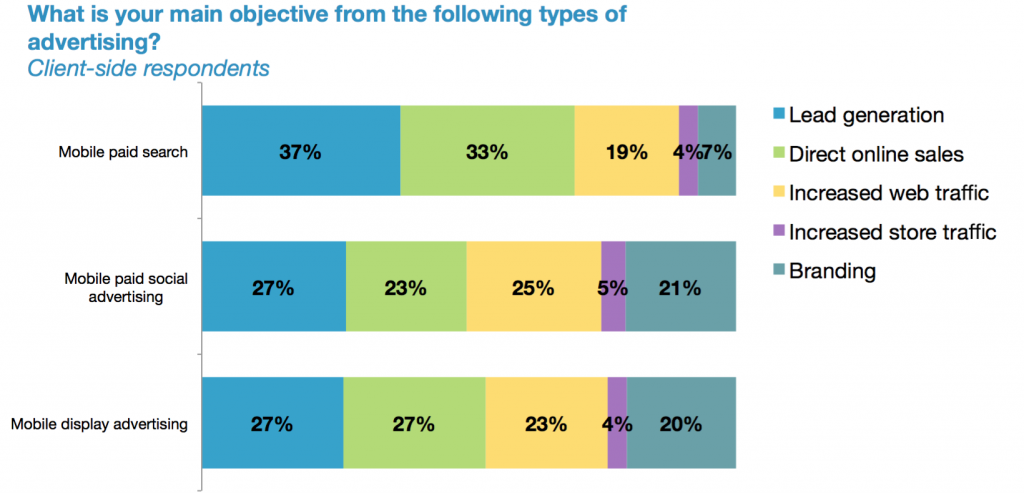
Paid search came out as the top mobile channel which marketers relied on to meet lead gen and sales objectives partly because paid search is easier to measure compared with other mobile ad formats.
Paid social can be similarly easy to measure effectively. However consumers often have a lower purchase intent when using social media than when searching, so the objectives for this channel lean more towards branding and traffic.
Some marketers believe that ROI in mobile advertising is lukewarm or unclear, especially when compared with more tried and trusted desktop media approaches.
Overall, mobile advertising was described by fewer than a quarter (23%) of respondents as delivering 'excellent' or 'good' ROI, while a similar proportion deemed it poor (20%).
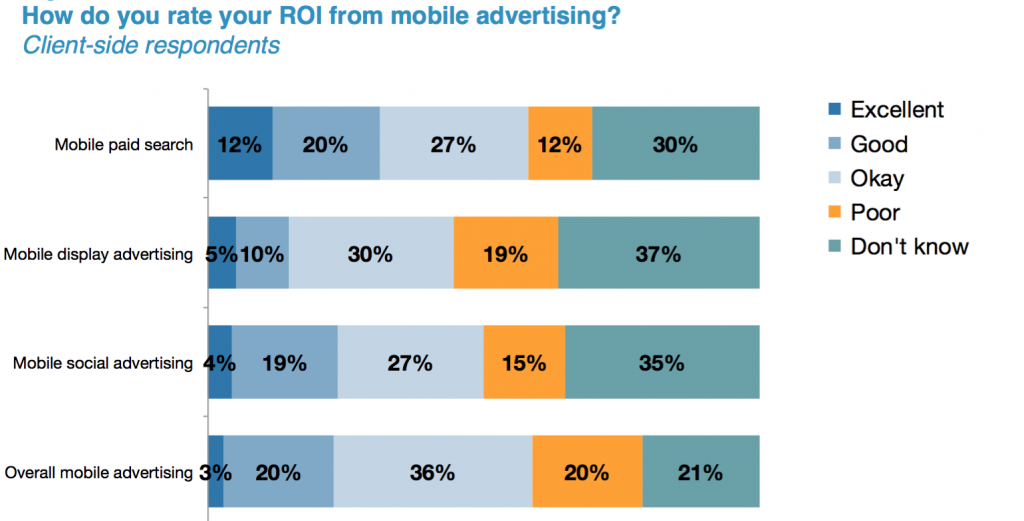
Questions around both ROI and ROI visibility are raised markedly around display and social advertising channels for mobile.
Only 15% of marketers deemed mobile display advertising as providing 'excellent' or 'good' ROI, and only 23% said the same for social. Compared to search, which 32% viewed as positive.
The greater confidence in mobile paid search ROI is also evident when looking at both client and agency side marketers. Marketers on both sides consider search a safer bet when it comes to ROI, with 31% and 35% of respondents respectively rating this channel either 'good' or 'excellent' in terms of ROI.
Sunday, April 17, 2016
Thursday, April 14, 2016
Seth Godin: Nobody makes a purple cow by sticking with what's safe
Yesterday's over. Being different is what's going to help you win tomorrow – not simply repeating your previous success.
A century ago, Henry Ford made headlines with what seemed like an outrageous decision to double minimum wage. Instead of the standard $2.34, Ford workers would take home an unprecedented $5 for each working day.
It was a great move for the brand, as its workers were suddenly able to afford its products. However, Seth Godin – the legendary marketer, author and speaker who delivered the opening keynote at ClickZ Live New York this morning – pointed out that you can't just make one great decision and then coast on it. Because the world never stops changing.
“The idea of the assembly line is that we codify the work. We figure it out step-by-step and figure out what [workers] did yesterday to make the KPIs go up and make things more efficient,” said Godin, adding that managers inevitably want more.
“The challenge of that four-letter word is simple. Mass leads to average products for average people,” he continued. “If you want to reach everyone, you better have something everyone wants to buy, which leads to average, which means the same thing as mass.”
Opening keynote with Seth Godin @alt_MBA #CZLNY pic.twitter.com/GgdxIQVMDy
- Tetyana (@mitetyana) April 12, 2016
The point there is that just because something worked, doesn't mean you should just stick with it indefinitely.
Ford is still around today because the brand didn't achieve success and then rest on its laurels. Ford recognized that having the best factory is ultimately not what brought on the brand's prosperity.
“You don't win because you have the better factory,” said Godin. “You win because you were connected because people were loyal, because people are interested in hearing you.”
Godin added that all of the brands who have thrived in the last decade or so hasn't followed the status quo of what's worked for brands in the past. The Airbnbs, Zappos and Lululemons of the world have, instead, focused on being purple cows.
The title of one of Godin's 18 books, the term “purple cow” refers to the idea that you can drive through Texas and see thousands of cows, not noticing any of them. But if you see a purple cow, you'll not only look twice, but probably stop your car to Instagram it.
“You know what a purple cow is? Remarkable. You know what that is? Something worth making a remark about,” said Godin. “Almost all marketing pain is caused by organizations who don't have the guts to make something remarkable, instead trying to use money to solve a problem.”
The thing that's remarkable isn't going to appeal to everyone. But it's going to appeal to the right people. For example, there are roads everywhere, but people still fly out to Hawaii and pay thousands of dollars to participate in the Ironman. Why? They feel like they're a part of the tribe.
To put this example visually, Godin said that nobody gets a Suzuki tattoo. (On Twitter, someone commented that actually, yes, they do, but the Harley-Davidson logo generally adorns far more people's bodies.)
Closing out his keynote, Godin put one of his favorite photos onscreen. It shows the attendees of a long-ago Solvay Conference, a periodic meeting for the best and brightest in the world of physics. People in the photo included Albert Einstein and Marie Curie; 17 of the 29 people pictured have won the Nobel Peace Prize.
“You didn't get invited [to the Solvay Conference] because you won the Nobel Peace Prize. You won the Nobel Peace Prize because you got invited,” said Godin. “You need to be in the room where it happens and then you get to decide what to do about it.”
What you can do is stop being afraid and just do something different. You can choose to redefine your industry, rather than being a cog in the system. And you can choose to matter.
“You have the dials, the levers, the trust and the privilege to take responsibility,” said Godin. “What people are saying to you, as clearly as they can, is they need you to lead them.”
Wednesday, April 13, 2016
How will online advertisers and retailers benefit from Google AdWords redesign?
In this mobile-first world, Google is continuously monitoring the growth of usage on mobile devices and looking for ways to improve advertiser's ability to adapt to this new multichannel behaviour.
That is why the search engine giant, shortly after revealing a new layout for its SERPs, has redesigned the AdWords interface which is where online marketers and merchants display copy on its search engine and manage their campaigns in one place.
When the interface was first created in 2001, it was exclusively for text-based ads but now it includes a variety of features including the management of Google Shopping ads and display-based campaigns.
Google also worked closely with advertisers and listened to their feedback so they could tailor these changes specifically to their needs.
Here are some of the key areas Google has focused on in the redesign of AdWords:
- Focused approach on business objectives: AdWords, instead of focusing on features, is now more in tune to manage marketer's campaigns according to their business goals. For retailers, this could be for example increasing traffic to their e-commerce website or increasing sales.
- Easy to access, relevant data: Google AdWords, now offers easy access to insight and data which are relevant to the company's business goals. With this new version advertisers will now be able to find out the percentage of traffic coming from mobile for example or even find out the campaign which results in the most profit for the business.
- Do more in less time: Updates to Google AdWords support will help online advertisers to be more efficient with their time by helping them manage the most important settings more easily. This includes building reports and even managing ad extensions all from the same dashboard location.
- Graphical view of clicks and conversions: Advertisers will be able to see the evolution of their clicks and conversions over one month. This new version will be easier to read than the current one.
- Overview of top ad groups: just under the graph from the overview screen, the new design shows the top five ad groups, with their cost, number of conversions and impressions.AdWords users will see at a glance which of their ad groups perform best. For retailers, this could be a good way to quickly know their most popular product categories on AdWords.
- Performance by device: the overview will also show the performance for each device (desktop, tablet, smartphone) according to three KPIs: clicks, impressions and cost. This data was accessible in the older version of AdWords through much more clicks. With this new view, Google recognises the importance of advertising on multiple channels.
- Key settings are more visible: Access to data via mobile, tablet and desktop is much faster and more easily accessible. These were hidden in the earlier versions of the tool but these can now be accessed from the left sidebar: Location, Ad Schedule, Devices.
- Personalisation: From the first preview of the interface, we can expect that, like in Google Analytics, there will be enhanced personalisation options including a custom dashboard with the most relevant metrics for advertisers.
So what are the key benefits these changes provide to advertisers?
The thinking behind the Google AdWords redesign was to allow advertisers to manage the complexity of online advertising.
It aims to answer online advertiser's needs, whilst also adapting according to the sheer complexity of managing a variety of different advertising campaigns and several formats including video, display, Shopping and AdWords.
With more Google searches now taking place on smartphones than on computers, the redesign also allows advertisers to refine their advertising strategy for each device.
Retailers will be able to improve their performance to reach consumers in their “micro-moments”, which happen whenever they need information.
In terms of the visual look and feel, it is the same design which is used in other native Google products. As such, retailers who are already using Gmail or Google Maps will be familiar with the platform (unlike the current version, which looks quite complicated for a beginner), thus they will feel much more at ease to start using AdWords if they don't already.
The new interface also simplifies access to the most relevant tools in order to reach specific aims. For beginners the interface becomes more accessible and “user-friendly”, and there is no need for a wider practical knowledge of AdWords tools.
It will also be useful for the more experienced users as it will help them save time in their daily workflow management. More information and settings in less clicks.
The KPIs are also easily accessible with the new interface and allow advertisers to keep an eye on performance and make the necessary adjustments quickly. With this new interface, advertisers will have a better understanding of the key performance indicators, and have more powerful tools at their fingertips to manage their campaigns of any device.
As a result, we can expect this redesign to help optimise advertiser campaigns at a base level and improve the ROI of their advertising spend in the long term.
Below is a snapshot of what the new interface will look like:
It's worth keeping in mind that this redesign will not happen overnight. The change will be a long process, so don't be surprised if you continue to see the original AdWords interface for a few more months.
Initially, Google will provide access to certain areas of the redesign to a select group of advertisers so that they are given the opportunity to test out these new features and provide immediate feedback to the development team.
However, the redesign and updated look and feel will be made available to all advertisers by the end of 2017 and shouldn't affect the overall structure of your performance campaigns.
The new design is already available in the AdWords mobile app (Android version released last year, iOS launched in January 2016), allowing advertisers to access their data on smartphone and tablet.
It will be interesting to see if Google continues to roll out more feature sets and changes, as it continues to enhance the AdWords experience to its advertiser user base throughout 2016 and into 2017.
Tuesday, April 12, 2016
Everything you need to know about natural language search
Search engines like Google, Bing and others are making efforts to bring searching for information in line with everyday conversation with a type of search called 'natural language search'.
This development is a move away from the type of searching that has dominated the web since the advent of search engines in the 1990s. It is part of an attempt to make searching faster and more effective by understanding searcher intent and more complex, multi-part queries.
Natural language search is also key to a number of advancements currently taking place in technology, including voice search, digital assistants and smart home hubs. But what exactly is it, and how is it going to affect the way that we look for information online?
What is natural language search?
Natural language search is search carried out in everyday language, phrasing questions as you would ask them if you were talking to someone. These queries can be typed into a search engine, spoken aloud with voice search, or posed as a question to a digital assistant like Siri or Cortana.
This is as opposed to keyword-based search, which is what most people who are used to using web search engines still default to. Keyword-based search is an attempt to break down a query into the most important terms, getting rid of unnecessary connecting words like “how”, “and”, “the”, and so on.
So if you wanted to know how high the Empire State Building was, a keyword-based search query for that information might be “Empire State Building height”. But if you were searching using natural language, you would phrase your query as, “How high is the Empire State Building?”
“Don't speak in these weird haikus.” CollegeHumor's 'If Google Was a Guy' series satirises keyword-based search queries by placing them in a life-like context.
Natural language search has always been around – think of Ask Jeeves, the 1990s search engine which encouraged users to phrase their queries in the form of a question. But Ask Jeeves was ahead of its time; keyword-based searching was the norm then, and Jeeves found itself out-competed by more powerful keyword engines like Google.
Several years too late for Ask Jeeves, search trends are coming back around towards natural language search. This is the result of a number of different developments in search and technology coming together.
The trend towards natural language
First of all, search engines – particularly Google – have improved their search capabilities so much over the years that people expect to find exactly what they're looking for on the first try.
There's a reduced patience for sitting and trying different keyword combinations; people are searching on their mobiles, on the go, and they want to be able to ask a question, get the answer, and move on. And search engines have worked hard to meet this expectation, so that people will feel satisfied with the service they provide instead of frustrated by it.
Secondly, search technology has improved to the point where we can begin to teach search engines to understand longer, more complex queries, with different components that modify each other and can't operate independently.
Google recently published a blog post welcoming “complex questions” and illustrating how its search engine can now understand superlatives (tallest, largest, oldest) and “ordered items”, such as a list of the largest cities in a given state, in order of area.
Google now also has an improved ability to interpret specific dates, and complex, multi-part queries like “Who was the U.S. President when the Angels won the World Series?”
You'll notice from the screenshot that Google doesn't just aim to serve the right answer to that question, but to display it within the Knowledge Graph at the top of the screen, eliminating the need to even click on another site in order to find the answer.
The third key component contributing to the development of natural language search is the rise of voice search and digital assistants. As Rob Kerry noted in his presentation on the future of search at Ayima Insights digital marketing conference, “It's becoming a lot more common for people to search by talking into their phone.”
Amazon's Alexa, Apple's Siri, Microsoft's Cortana, Google Now – these AI assistants are being adopted more and more widely, and their voice activation capabilities increasingly integrated into technology.
The technology might have had its stumbling blocks at first, but as with Google, it's improving steadily, leading people to become much more used to speaking commands and queries aloud in everyday, natural language and expect an accurate response in return.
Will Oremus of Slate put the progression to natural language search best when he described it as a move from us speaking the language of computers in order to communicate with them, to us teaching them our language.
“In the beginning, computers spoke only computer language, and a human seeking to interact with one was compelled to do the same. First came punch cards, then typed commands such as run, print, and dir.
The 1980s brought the mouse click and the graphical user interface … the 2000s, touch screens; the 2010s, gesture control and voice. It has all been leading, gradually and imperceptibly, to a world in which we no longer have to speak computer language, because computers will speak human language-not perfectly, but well enough to get by.”
It's not just Google
As the world's most popular search engine, it's not really a surprise that Google is leading the pack in natural language search advancements. But it hasn't been the only search engine to do so by any means.
In 2014, Microsoft made updates to Bing smart search which improved its parsing of natural language queries. A few months later, it developed on this even further by introducing the ability to “continue the conversation” after asking a question in search. In other words, you can ask a follow-up question which depends on the previous one for context, and Bing will understand what you mean.
This works, and it's quite impressive – ask Bing who the “President of America” is, and then in a separate query, ask “how tall is he?” and you'll get the right answer, with the height of the First Lady and a couple of other presidents thrown in just in case.
Of course, it depends on the first question being one that Bing can answer, which mostly restricts it to simple “who is…” or “how is…” questions. Still, not even Google, which always treats individual searches as a new query, can do this, and it's a big step towards the kind of frictionless, conversational searches that natural language search aspires to.
Newer search engines are also making natural language search capability their goal. Plonked, a niche business-focused search engine which launched in March, aims to provide its users with a natural language interface in order to keep up with the level of searching offered by Google and other major search engines.
I also made an unexpected discovery when researching this article, which is that Ask Jeeves is not the only natural language question and answer service left over from the 90s. START is a “natural language question answering system” developed by the InfoLab Group at MIT, and it has been online since 1993.
START functions more like a reference book than a search engine, designed to give factual answers to questions in fields like geography, science, history and culture.
It also might be a little out of date. But it has an ability to puzzle out the different components of a complex query in a way that Google could stand to learn a thing or two from – and by the look of things, has been doing it for much longer than Google has.
Where next for natural language search?
We've published a number of articles on where Google is going with search, from using Hummingbird to better understand searcher intent, to employing RankBrain to guess at the meaning of never before seen questions, to making strides towards semantic search.
Natural language search is bound up with all of these, since these are all capabilities that would allow Google to better interpret and respond to search queries in everyday language. So I think it's fair to say that we can expect much better and more accurate natural language responses from Google as these algorithms learn, develop and have their limits tested.
But as we've established, it's not just about Google. There's a possibility that we'll see natural language search developing in a few different directions as Bing furthers its 'conversational' search style, and other search engines play to their own strengths.
The kinds of natural language search queries that a niche engine like Plonked needs to interpret and respond to could be very different from those put to a general search engine, which could lead to some interesting advances in unexpected areas.
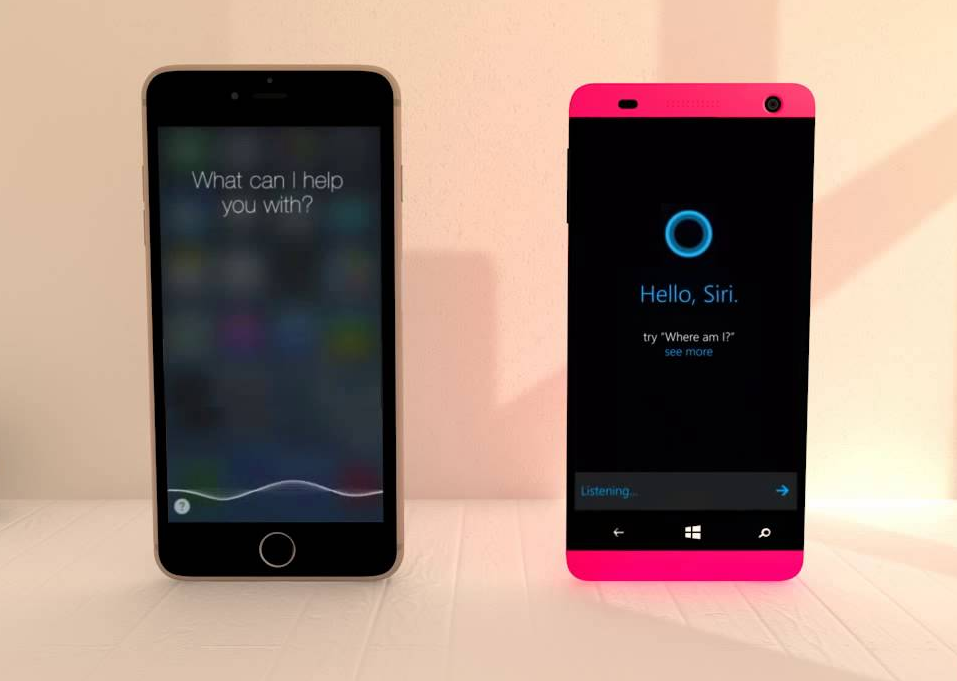
Screen capture via GV Commerciais
There are even bigger developments taking place in the 'digital assistant' field, which is heavily tied together with voice and natural language search as digital assistants handle search queries along with a myriad of other tasks. Siri, Cortana, Alexa and others are all threats to Google's dominance of search, and there are rumours that Google is planning to develop its own voice-controlled assistant device to take on Amazon's Echo in the smart home space.
Natural language search is not only a direction that search engines are overwhelmingly moving in in order to better understand the goals and desires of searchers online, but also a key component of some of the most important – and, let's be honest, futuristic – developments currently happening in the field of technology.
Monday, April 11, 2016
Google Accelerated Mobile Pages and content: the need for speed
When Google launched the mobile update in April 2015, it was intended to reward brands with mobile-friendly websites. Even without the update, however, marketers can not ignore the increasing importance of mobile.
More searches are now performed on mobile compared to desktop and m-commerce grew three times faster than ecommerce in 2015.
Even aside from purchases made on the devices themselves, mobile is also having a tremendous impact on in-store purchases. According to Deloitte, mobile has an impact of $970 billion on offline purchases.
These changes force brands to have a mindset shift. Instead of just being mobile-compatible, they need to be mobile-optimized. Sites need to think specifically about what mobile customers want to see and create sites and online experiences that are tailored to them.
One of the most important factors in the mobile experience is speed. About 40% of visitors will abandon a site if it does not load in 3 seconds. This means that companies are potentially experiencing massive losses in traffic and revenue if their sites do not meet the needs of customers.
Google's solution to this problem has been the launch of AMP, or Accelerated Mobile Pages.
What is AMP?
Accelerated Mobile Pages is a stripped-down version of the mobile web which runs on a reinvented version of the language used to create web pages: HTML.
AMP has the potential to help brands to speed up their sites. Google claims that there is a 58% drop off when pages take 10 or more seconds to load. Using AMP, however can improve load time by as much as 15 to 85%.
AMP accomplishes this by stripping away everything that is 'extra' on the page so that the site loads faster. This means features, such as lead capture forms and on-page comment sections, will be disabled.
Regarding your content, the following rules will also apply:
- AMP HTML will limit existing styles and tags
- AMP .JS will asynchronously load external resources and will stop any external scripts that are preventing page renderings
- AMP CDN is an optional content delivering network that will cache your pages that have been AMP-enabled so that they can be instantly accessible on mobile.
It is also important to use the available schema markups to make the different aspects of your site clearer to the search engine.
How SEO and content can keep pace
Site
Even for sites that are not using the AMP features, fast load times remain a necessity.
Although AMP itself is not specifically a factor in the current Google algorithm, load time is. Also, as AMP becomes more popular, customers will become accustomed to fast loading pages.
This makes them even more likely to click off of slow pages. If you are not using AMP, lower your load times by minimizing features such as large images and reduce your use of cookies.
Content
Mobile optimization also requires content that is on point. This means it adds immediate value to the user and that it takes into account what mobile users want to see.
If your mobile users regularly search your site for your physical address, make it easier to find to improve the user experience.
For example, the BBC has been quick to adopt AMP across all of its news content – creating content for desktop search and for AMP search.
Search
Organic
It is likely that AMP will also have a tremendous impact on organic search.
Since AMP sites will be at the top of the SERP on certain mobile searches, they will push everything else down. When this is combined with the paid search options also taking up space above the fold, organic search will become fiercely competitive.
Brands need to make sure they capitalize on every opportunity to improve their rankings– including content quality, distribution and optimization.
Paid
The fast load times may mean that customers will view more pages. This will increase the opportunities for ads to display.
Google has said that mobile ads now need to focus on the following:
- Loading as fast as AMP sites
- Being well-crafted and visually pleasing
- Being safe– ie using HTTPS
- Integrating across industries
Measuring
As you move forward with your new content strategy, it is important to remember that measuring success in the age of mobile does not just mean looking at site speed– you also need to understand how the content is performing.
It is vital to ensure that you follow mobile best practice steps and methodologies to stay mobile friendly.
Speed is one factor but you still need to have separate metrics where you track the engagement and conversion rates on your mobile site to see how well customers are responding to your content when they are on their phones or tablets.
Mobile is quickly becoming a dominate player in the world of marketing and AMP is changing customer expectations and the user experience.
Rather than looking at mobile marketing as a requirement to check off, focus instead on mobile optimization and see what you can accomplish with your on-the-go visitors.

